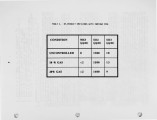| Title |
Advanced Non-Catalytic Post Combustion NOx Control |
| Creator |
Chen, S. L.; Lyon, R. K.; Seeker, W. R. |
| Publisher |
University of Utah |
| Date |
1990 |
| Spatial Coverage |
presented at San Francisco, California |
| Abstract |
The effectiveness of combustion modifications, including staged combustion and reburning, for the control of nitrogen oxide emissions from coal or oil fired combustors is most often limited by problems due to carbon burnout or flame impingement. This paper presents new data on the use of selective reducing agents, such as ammonium sulfate, suggesting that a hybrid control scheme is possible which uses combustion modification to provide those conditions which optimize the selective reduction process. Very low emission levels appear possible that can presently only be achieved by catalytic reduction. |
| Type |
Text |
| Format |
application/pdf |
| Language |
eng |
| Rights |
This material may be protected by copyright. Permission required for use in any form. For further information please contact the American Flame Research Committee. |
| Conversion Specifications |
Original scanned with Canon EOS-1Ds Mark II, 16.7 megapixel digital camera and saved as 400 ppi uncompressed TIFF, 16 bit depth. |
| Scanning Technician |
Cliodhna Davis |
| ARK |
ark:/87278/s670840c |
| Setname |
uu_afrc |
| ID |
5797 |
| Reference URL |
https://collections.lib.utah.edu/ark:/87278/s670840c |












